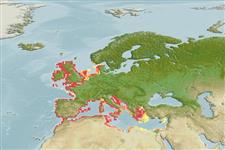Common names from other countries
>
Blenniiformes (Blennies) >
Blenniidae (Combtooth blennies) > Salariinae
Etymology: Parablennius: Greek, para = the side of + Greek, blennios = mucus (Ref. 45335).
More on author: Linnaeus.
Environment: milieu / climate zone / depth range / distribution range
Écologie
marin démersal; non migrateur; profondeur 3 - 32 m (Ref. 5981). Subtropical; 59°N - 31°N, 11°W - 35°E
Northeast Atlantic: Atlantic coast from Ireland to Morocco; also in the Mediterranean Sea and the Sea of Marmora. This species is present only in mainland Portugal (Ref. 13612). Although older papers reported this species from the Azores and Madeira, it has been concluded that the occurrences were misidentifications of Parablennius ruber (Ref. 13612).
Taille / Poids / Âge
Maturity: Lm ? range ? - ? cm
Max length : 30.0 cm TL mâle / non sexé; (Ref. 3397); common length : 17.5 cm TL mâle / non sexé; (Ref. 3397)
Épines dorsales (Total): 13 - 14; Rayons mous dorsaux (Total): 17-20; Épines anales 2; Rayons mous anaux: 19 - 23. Gill membranes not forming fold across isthmus. Tentacles on nasal openings and above eyes. No canine teeth in upper jaw. Dentaries joined by ligament. Frontals not covered by parietals. Spawning males chocolate-brown, with bulb glands on spiny anal fin rays. Lateral line continuous with branches but discontinuous posteriorly.
Facultative air-breathing (Ref. 126274); Active mainly during dusk and dawn (Ref. 5204). Adults live in rocky while young are found in shallow water in the seaweed zone. Oviparous (Ref. 205). Spawn in March - May. Male guards the eggs from several females, until larvae about 1 month (Ref. 35388). Eggs are demersal and adhesive (Ref. 205), and are attached to the substrate via a filamentous, adhesive pad or pedestal (Ref. 94114). Larvae are planktonic, often found in shallow, coastal waters (Ref. 94114).
Spawning males reside in holes where several females spawn. Males, thus, guard the eggs. Oviparous, distinct pairing (Ref. 205).
Wheeler, A., 1992. A list of the common and scientific names of fishes of the British Isles. J. Fish Biol. 41(suppl.A):1-37. (Ref. 5204)
Statut dans la liste rouge de l'IUCN (Ref. 130435)
CITES (Ref. 128078)
Not Evaluated
Menace pour l'homme
Harmless
Utilisations par l'homme
Pêcheries: intérêt commercial mineur; Aquarium: Commercial
Plus d'informations
RéférencesAquacultureProfil d'aquacultureSouchesGénétiqueElectrophoresesHéritabilitéPathologiesTraitementMass conversion
Outils
Articles particuliers
Télécharger en XML
Sources Internet
Estimates based on models
Preferred temperature (Ref.
115969): 9.9 - 19.8, mean 17.4 (based on 701 cells).
Phylogenetic diversity index (Ref.
82804): PD
50 = 0.5000 [Uniqueness, from 0.5 = low to 2.0 = high].
Bayesian length-weight: a=0.01175 (0.00750 - 0.01842), b=3.05 (2.92 - 3.18), in cm Total Length, based on LWR estimates for this species & Genus-body shape (Ref.
93245).
Niveau trophique (Ref.
69278): 3.6 ±0.0 se; based on diet studies.
Résilience (Ref.
120179): Haut, temps minimum de doublement de population inférieur à 15 mois (tm=1).
Fishing Vulnerability (Ref.
59153): Low vulnerability (20 of 100).
